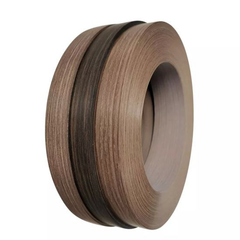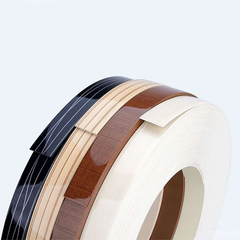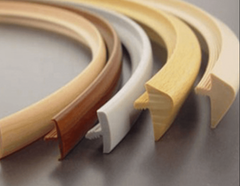What is edge banding?
Furniture is made up of different parts, like plywood, or wood. Sometimes, these parts have rough and sharp unsafe edges that are not even, and if left exposed, can cause serious damage to you, your loved ones, and your furniture. Imagine accidentally bumping into such edges or getting your fingers caught in them. To prevent such accidents and create a more refined look, manufacturers use thin strip materials called edge bands. This results in a durable, solid, glossy look that will aesthetically please and protect you.
Type of edge bands:
Wood Veneer Edge Banding is constructed from real wood that has been pre-sanded and stacked together. It has a natural and elegant appearance that complements the wood grain of the furniture. Wood veneer edge banding is non-toxic and can be stained or polished.

Polyvinyl Chloride (PVC) Edge Banding is a type of plastic polymer material that becomes moldable at certain high temperatures and then becomes solid after cooling. This makes it a more versatile and widely used material capable of withstanding daily wear and tear. It is highly suitable for areas prone to humidity or moisture exposure, such as kitchens or bathrooms. This type of edge banding is excellent at moisture resistance, very easy to clean and maintain, and is widely available in many colors, patterns, and textures.

Acrylonitrile Butadiene Styrene (ABS) Edge Banding is similar to PVC in that both are polymer materials, making it impact resistant. Made from a material that is non-toxic, ABS edge bands are highly durable and capable of withstanding extreme temperatures, and it is also completely waterproof, making it ideal for outdoor applications.

Polypropylene (PP) Edge Banding is known for its high chemical resistance. As a thermoplastic material, it is also lightweight and has good flexibility. Although it may not have the same level of durability as PVC or ABS, PP edge banding is suitable for applications where chemical exposure or impact resistance is important.
Polymethyl Methacrylate (PMMA) Edge Banding is a transparent or translucent material used for edge banding created from methyl methacrylate. This chemical compound offers a high-end, glass-like appearance to furniture. Although that results in it being more expensive compared to other options, PMMA edge banding is scratch-resistant, UV-stable, and provides excellent clarity.

Melamine Edge Band is a resin-saturated paper that is often coated on the back with a special hot melt adhesive. As a strong material that can protect the corners of wooden furniture, Melamine is superior to most edgebanding solutions available in the market, and also compatible with most forms and materials of furniture. As one of the most flexible and eco-friendly materials for furniture, it can be used extensively in the manufacture of cabinets, shelves, worktops, and wardrobes.

Transition (T) Molding Edge Band is a plastic molding edging used on a variety of products, such as tables, countertops, and boats. Transition molding helps one surface transition to another of equal thickness so that there are no abrupt or unfinished edges that are unsightly or unprotected. Some are installed with tracks and screws, others are meant to be glued or nailed to the subfloor.

Material Origins and Ideal Surfaces:
The majority of edge banding materials are synthetic and are mass-produced in facilities all over the world. The rest, like wood veneer edge bands, are often made from hardwoods obtained from sustainable forests, adding an eco-friendly element to your designs. Edge bands can be used on a variety of surfaces, but they are most typically employed on plywood, particleboard, and medium-density fibreboard (MDF) wood since these materials have rough, unequal edges. Edge bands can be used on cabinets, cabinet doors and drawers, shelves, tables, furniture, fixtures, and countertops.
What is the edge banding thickness?
Deciding the right edge band thickness for your project can be a little daunting but you should consider the type of the project and quality! The thickness can range from 0.018-inch to 5mm thick.
How wide should my edge banding be?
The width of edge banding varies depending on the type of material used and the intended use of the furniture. However, as a general rule, your edge band should be a little wider than what you are expecting. For example, let's say you're working with a standard board that's between 15mm and 19mm thick. You'd want to use edge banding that's about 22mm to 2 inches (or about 50mm) wide. This little extra width makes sure the edge banding covers the entire side of the board and gives a neat finish after it's trimmed down.If you have a special project or an unusual thickness of the board, you can also ask for custom widths of the edge banding. Just remember that this might cost a bit more and take a little longer because it needs extra work.
The Art of Applying Edge Bands:
Before buying an edge band for your next project, one of the crucial decisions is how you want to apply it. There are options to select edge bands that are pre-glued; these are the easiest to use. The adhesive pre-applied to edge banding is typically a type of hot-melt adhesive based on EVA (Ethylene-vinyl acetate), a type of copolymer that provides excellent bonding properties and heat resistance. This glue is solid at room temperature but melts when heated, allowing it to bond with the edge of the board. One of the simplest and most accessible methods to apply pre-glued edge banding is by using a household iron. After cutting the edge banding to the desired length, position it on the edge of your board. Then, using an iron set to a medium to high heat setting, slowly press and move the iron along the banding. The heat from the iron activates the adhesive, bonding the edge banding to the board. After application, trim any excess material for a neat finish.
If you are selecting edge bands that are non-glued, a common way to apply it is by manually applying glue that’s usually derived from Polyvinyl acetate, also known as PVC, to the edge of the panel and the banding, then using clamps to hold the banding in place while the glue dries. PVA glue is easy to work with, provides a strong bond, and dries clear, which makes it an excellent choice for many woodworking projects. Please note that for edge banding materials like PVC or melamine, a more specialized adhesive may be required. Contact cement is often used for these materials because it provides a strong bond and can withstand the heat generated by trimming and sanding processes.This method provides excellent control over the process but can be time-consuming, especially for larger projects.
For all edge bands, whether pre-glued or not, an edge banding machine is the preferred method. These machines automate the process, ensuring a consistent and fast application. They can handle different thicknesses and widths of edge banding and often come with trimming units to trim the excess banding after application. These machines are designed to apply glue to the banding and then press it onto the panel edge. Some machines also trim the excess banding for a neat finish. Using a machine can speed up the process and ensure a consistent, high-quality result.
Happy woodworking!
Whether for safety or aesthetics, edge banding is an indispensable aspect of furniture design. The type of edge band used can dramatically affect the overall appearance, durability, and functionality of the furniture piece. Understanding the different types of edge bands and their applications allows one to make informed choices in furniture design and manufacturing.
Frequently Asked Questions (FAQs)
1. What is edge banding?
Edge banding is the process of applying a thin strip of material, known as an edge band, to the rough and sharp edges of furniture parts, such as MDF, Particle board, plywood, or wood. This process is used to prevent accidents, create a more refined look, and improve the durability of the furniture.
2. What materials are used to create edge bands?
Edge bands can be made from a variety of materials, including:
- Wood Veneer: Constructed from real wood slices, it provides a natural look but may be more susceptible to moisture.
- PVC: A plastic-based material known for its durability and excellent moisture resistance.
- ABS (Acrylonitrile Butadiene Styrene): A less dense and environmentally friendly material compared to PVC, with good durability and heat resistance.
- PP (Polypropylene): Known for its high chemical resistance and good flexibility.
- PMMA or Acrylic: Offers a high-end, glass-like appearance but can be more expensive and may have lower impact resistance.
- Melamine: A flexible and durable material, usually coated with a thin layer of MDF or PVC plastic.
- T-Molding: Requires creating a special groove or slot for the “T” part of the molding to fit into.
3. What is the thickness of edge banding?
The thickness of edge banding can range from 0.018-inch to 5mm thick, depending on the quality and type of the project.
4. How wide should edge banding be?
The width of edge banding should be a little wider than the thickness of the board. For a standard board between 15mm and 19mm thick, edge banding about 22mm to 2 inches (or about 50mm) wide is typically used.
5. How is edge banding applied?
Edge banding can be applied manually or using an edge banding machine. Pre-glued edge banding, which has adhesive applied to the back, can be applied using a household iron or an edge banding machine. Non-glued edge banding requires applying glue to the edge of the panel and the banding before attaching.
6. What types of glue are used with edge banding?
The type of glue used with edge banding depends on whether it is pre-glued or non-glued. Pre-glued edge banding typically uses a type of hot-melt adhesive, often based on EVA (Ethylene-vinyl acetate). Non-glued edge banding requires manually applying glue, which can be wood glue (PVA - Polyvinyl acetate) for real wood banding or contact cement for materials like PVC or melamine.
7. Where are edge banding materials produced and where are they typically used?
Most edge banding materials are synthetic and mass-produced worldwide. Wood veneer edge banding is often made from hardwoods obtained from sustainable forests. Edge bands are most typically employed on plywood, particleboard, and MDF, which have rough edges that need to be finished.
Recent Blogs
-

ULTRAPAN luxury polymer panel - modern kitchen cabinets material
Read more -

How to Choose the Right Wood Board for Your Woodworking Project
Read more -

The Importance of Boards in Various Sectors
Read more -

What is a Laminate Sheet – Types and Uses
Read more -

Understanding the Differences: ABS vs PVC Edge Banding
Read more -

What is Edge band?
Read more














